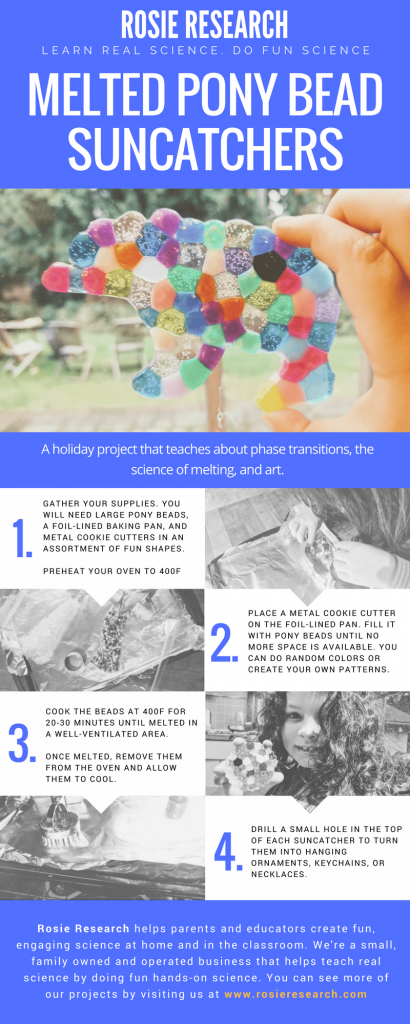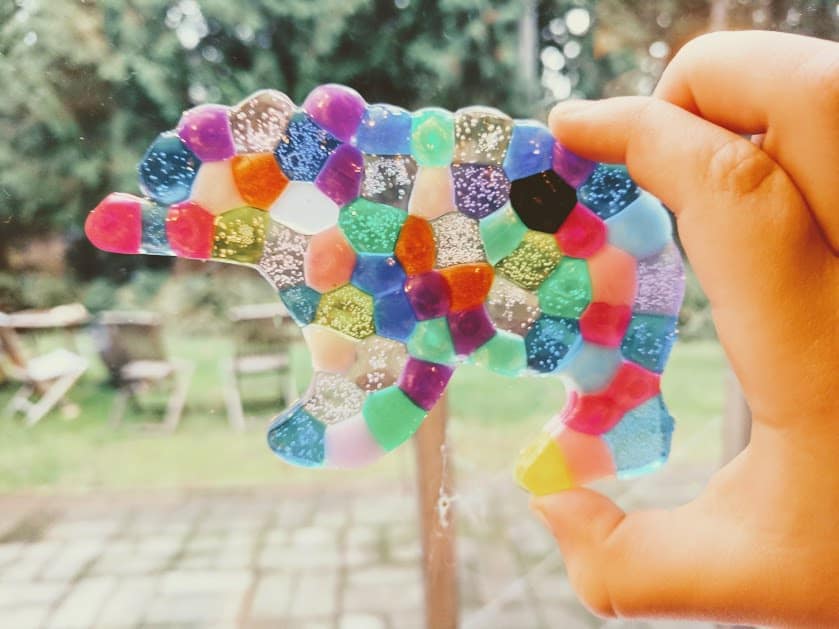Melted Pony Bead Suncatchers for Winter Science Fun
Winter in Seattle can be a dreary, dreary time. With the rain and the gray skies, a little touch of color is always a welcome addition. I saw these melted pony bead art projects online the other day and thought not only would it be a fun art project, but also a great opener to talking about a ton of science! This project lets us talk about how things melt, and even what things melt, as well as how light interacts with materials. We made suncatchers and necklaces with our final pieces!
If you have kids, you likely already have everything you need on hand, pony beads, foil, metal cookie cutters, and an oven. We happened to have color changing UV beads on hand from a previous science project. I have no idea if these will still change color after the baking process (since the gray skies mean I can’t really check). I suspect they still should though since the color changing polymer was at one point in the melted plastic as it got molded into pony beads.
How to make melted pony bead art
Project Ingredients:
Pony beads
UV beads (for a color changing suncatcher)
Metal cookie cutters
- Preheat your oven to 400 degrees
- Line baking pans with foil
- Place a metal cookie cutter on the foil
- Fill with pony beads
- Bake for 20-30 minutes (do this outside if possible)

It’s that easy! Seriously! And the payoff with this melted pony bead art is HUGE! You get some insanely pretty pieces that can be functional as well. We used a small drill bit to drill a hole in two of the pieces, one to hang from our window, and the other to turn into a necklace.
A side note on the UV beads: these melted just fine, but they didn’t bond with the other melted beads to create a nice solid piece upon cooling. Instead, the melted pieces of these beads could be wiggled like a loose tooth. We just put a small amount of Elmer’s glue along the seams. Here’s to hoping that they do still change color if the sun ever shines again!
The necklace reminded me so much of David McKee’s Elmer books. It would be so easy to turn this into a literacy connection if your preschooler is into those books.
Other ideas for turning these melted pony bead pieces into usable objects are keychains, bowls, hairpins, bracelet pieces, or shoe bling.
What is the science behind the melted pony bead project?
How do the plastic pony beads melt?
Plastic is a polymer. A polymer is a long chain of molecules that are bonded together. Some parts of the pony beads are a big mess of polymers, also known as amorphous, while other parts are nice and orderly, known as crystalline. When you put the pony beads in the oven you start supplying heat to the plastic polymers. When things get hot they start to wiggle around. As their vibrations get bigger they can start to move around. This happens first for the amorphous polymers, the ones that are like a tangled mess – and this makes the beads soft, but not melted. As more and more heat is added the vibrations start going into the crystalline polymers, disrupting their nice orderly structure. Once all of the crystalline structure has gotten hot enough and vibrated enough, the plastic will be melted! When we melt an item we turn it from a solid to a liquid, which means there was a phase transition that happened in your oven.
Can anything melt?
No. In fact, there is a lot of items around us that do not melt, one common example is wood. Unlike plastic (or metal, or water), wood burns instead of melting. Why doesn’t wood melt? For something to melt it has to be chemically the same before and after the melting process. For example, water and ice are both H2O, just in different configurations.
Wood is a mixture of a lot of different compounds; water, cellulose, ligands, etc. The biggest problem for wood melting is that wood oxidizes when heat is added to it (that is my fancy way of saying wood burns). As we add heat to wood the long chains of cellulose break down into smaller components and oxidize into things like charcoal. Since the structure of wood is demolished during the heating process it can’t be the same before and after, like water and ice are, and thus can not melt.
Sometimes even things that look like they melt, like sugar, don’t meet the standard because they decompose into shorter molecules when heat is added.
Why can I see through some of my melted pony beads but not others?
Everything we see and don’t see, in this world is due to how light interacts with matter. We can see chairs because they reflect light back to our eyes (specifically, if we see a brown chair we see the brown light reflected). We can’t see through chairs because they absorb all the other colors of light present. Think of every object as a hungry hippo, eating up some light and spitting out other light – just like our kids often spit out broccoli but eat corn. Any light that spits out we see as a color. Any light gobbled up or absorbed, we never see. Some of these hippos, however, can’t really decide if they like a color of light or not, and in this case, they neither eat (absorb) it, or refuse it (reflect it), instead they let it pass right on through them (transmit it). This gives us a clear item. If there is to be color that also looks clear you can add in molecules to absorb certain colors of light, giving the beads different colors.
When light passes through these sun catchers it will be absorbed by some of the beads (the opaque ones), and transmitted by others (the translucent ones). The translucent beads also have colors to them giving us a beautiful image on the table or floor to brighten up a dreary winter afternoon.

5 thoughts on “Melted Pony Bead Suncatchers for Winter Science Fun”
Comments are closed.